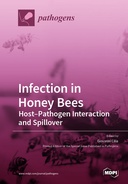Explore

Honey bee pathogens are spread worldwide and are strongly related to the decline of honey bee populations, which has severe implications for beekeeping, honey production and ecology. Honey bee pathogens are continuously studied by researchers with the aim to better understand the host–parasite relationship of these pathogens and the effects that they have on bee colonies. Honey bee pathogens include bacteria (i.e., Melissococcus plutonius and Paenibacillus larvae), microsporidia (i.e., Nosema apis and Nosema ceranae), fungi (i.e., Ascosphaera apis), protozoa (i.e., Lotmaria passim, Crithidia bombi and Crithidia mellificae) and viruses (i.e., ABPV, CBPV, IAPV, KBV, DWV, BQCV and SBV). All of these pathogens are able to infect other bee species; infections would have important implications for their life cycles (e.g., Osmia sp. and Bombus sp.) or cause unknown epidemiological effects for other hymenopterans. In addition, old and new invasive pests (such as Varroa destructor, Aethina tumida, Vespa velutina, etc.) necessitate more studies to define their role as possible vectors or possible sources of infection for honey bees. For these reasons, knowledge on honey bee pathogens has become a matter of public interest and is connected with the critical role of honey bee health. The aim of this Special Issue is to explore honey bee pathogens, considering any aspect in relation to host–pathogen interaction and highlighting the possible interaction and spillover with other bee species and invasive pests, through a series of research articles that focus on different aspects of pathologies.
This book is included in DOAB.
Why read this book? Have your say.
You must be logged in to comment.
Rights Information
Are you the author or publisher of this work? If so, you can claim it as yours by registering as an Unglue.it rights holder.Downloads
This work has been downloaded 116 times via unglue.it ebook links.
- 116 - pdf (CC BY) at Unglue.it.
Keywords
- 16S rDNA gene
- 16S rRNA
- Acarapis woodi
- acaricides
- acetic acid
- acute bee paralysis virus
- antropocene
- Apicystis bombi
- Apicystis spp.
- Apis cerana
- Apis dorsata
- Apis mellifera
- arthropods
- Bacteria
- bee biology
- bee viruses
- beekeeping
- Bees
- Biology, Life Sciences
- black queen cell virus
- Bombus spp.
- Bumblebees
- chito-oligosaccharide
- chronic bee paralysis virus
- coumaphos
- Crithidia bombi
- Crithidia spp.
- decision-making tool
- deformed wing virus
- flight muscles
- genetic characterization
- GIS
- Gut Microbiota
- Honey bee
- honey bee diseases
- honey bee virus
- honey bees
- honeybee immunity
- honeybee pathology
- honeybee viruses
- honeybees
- Hymenoptera
- hypopharyngeal glands
- insectageddon
- inter-species transmission
- invasive pest
- ITR2
- Kashmir bee virus
- Lotmaria passim
- Mathematics & science
- microsporidia
- n/a
- neogregarines
- NGS
- nisin
- Nosema
- Nosema apis
- Nosema bombi
- Nosema ceranae
- Nosema spp.
- nosemosis
- nosemosis control
- para-coumaric acid
- pathogens
- pathogens transmission
- Pesticides
- Phytotherapy
- plant protection
- population decline
- predictive model
- propolis
- Reference, information & interdisciplinary subjects
- replicative virus
- Research & information: general
- Risk
- sacbrood disease
- sacbrood virus
- Saccharomyces sp.
- Sequencing
- small hive beetle
- Soil
- spillover
- strand-specific RT-PCR
- tau-fluvalinate
- toxic unit
- transmission routes
- Treatment
- Trypanosomatida
- trypanosomatids
- urban area
- urban environment
- Vairimorpha ceranae
- Varroa destructor
- virus
- Viruses
- wild bees
Links
DOI: 10.3390/books978-3-0365-2963-9Editions

